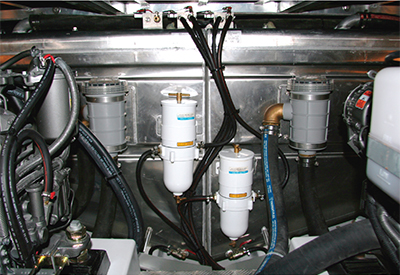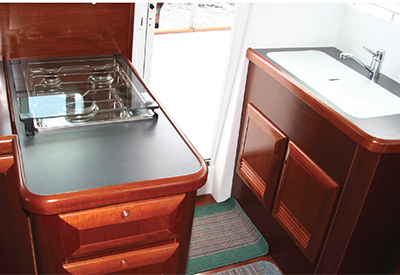Beneteau Swift Trawler 42
Reprinted From L’escale Nautique
Its elegance immediately elicits an admiring whistle. What a look! What style! Beneteau has not missed the mark with this entry into the trawler yacht category. A beautiful way to remember that the Beneteau family began business by constructing fishing boats.
The first of Beneteau’s Swift units, designed by architects Michel Joubert and Bernard Nivelt, were manufactured in France and imported into the US in 2004. Since then, the Beneteau shipyard in Marion, South Carolina has been producing all models destined for North America.
The gentle curve of the stem, the sweep of the hull caressing the water line, the series of portholes just below the gunwales, the side decks generous without being imposing, the rounded cap of the cockpit, and finally the foredeck placed well clear of the deck house are just some of the elements that contribute to the cruiser’s particularly harmonious lines. A lovely profile that will turn heads as it passes by, with a resolutely marine air. From your first turn on deck, you appreciate the spaciousness of the side decks, both comfortable and comforting thanks to the height of the bulwarks. Two steps take you to the bridge, well protected by stainless steel grab rails running amidships from the stem.
The tops of the gunwales feature rubrails right up to the foredeck, where you find all the space needed to manoeuvre the anchor and ground tackle. Two large lockers, an open pulpit with an electric windlass show that elegance has sacrificed nothing to the marine feel. The top of the deck house serves as a sunbathing platform.
Turning aft, you step through two doors before entering the cockpit. These doors serve to protect passengers from seaspray and heavy swells, a detail that underscores the level of comfort aimed for by this vessel.
 A hatch with an articulated cover gives access to the flybridge. Just enough space on the port side allows for a large ladder to the upper bridge. The antennas and a spotlight are located up here. Housing for a dinghy is also provided for behind the hatch. A bimini covers the cockpit, which can seat six comfortably. A sink, refrigerator and small table encourage you to relax. Beyond the comfort and a panoramic view, the upper bridge is especially quiet. At a cruising rate of 2,500 rpm, you barely hear the engines. In the lower cockpit the noise level is higher but still acceptable.
A hatch with an articulated cover gives access to the flybridge. Just enough space on the port side allows for a large ladder to the upper bridge. The antennas and a spotlight are located up here. Housing for a dinghy is also provided for behind the hatch. A bimini covers the cockpit, which can seat six comfortably. A sink, refrigerator and small table encourage you to relax. Beyond the comfort and a panoramic view, the upper bridge is especially quiet. At a cruising rate of 2,500 rpm, you barely hear the engines. In the lower cockpit the noise level is higher but still acceptable.
Keeping in mind that “swift” signifies rapid, a dozen years ago it was hard to reconcile speed with a trawler hull’s displacement. You could appreciate the livability, stability and seaworthiness of trawler yachts, but their slowness was regrettable. This new generation of fast cruisers, capable of planning at more than 20 knots, offers the best of both worlds. Strict weight control, mechanical muscle and incisive v-shaped hull sections constitute a recipe for a fast, comfortable cruiser capable of going up against the ocean’s moods. Chroniclers who tested the trawler on the sea (our trial took place on the calm waters of the Richelieu River) appreciated its stability, its passage through waves, and its responsiveness at the helm. The 370-hp Yanmar turbo-diesel twin engines, pushed to the maximum 3,380 rpm, can propel it to 25 knots. At this rate, the range is about 225 miles, but increases to more than 300 miles at 2,000 rpm, at an average 10 knots. Cruising speed sits somewhere between 18 and 20 knots, at 2,800 to 3,000 rpm.
This opens up the doors to semi-deep sea and extended coastal cruising in the greatest comfort, but fuel capacity is not always enough for big trips. With two propellers and a bow thruster, the Swift manoeuvers easily and with a draft of barely more than a metre, it allows you to explore less than deep bays without fear.
The engine compartment is accessed by a hatch in the salon. The floor in the salon is otherwise made of a solid sheet of aluminum bolted to the fibreglass structure. You can, while crouching, make your way around the motors.
 Reservoirs and filters are installed on the forward bulkhead, while all electrical systems are in the rear. The six batteries are located in the central passageway. There is a vast storage area for fresh water supplies, with all the room needed for a generator, watermaker and any other accessories you can think of. The storage capacity is impressive.
Reservoirs and filters are installed on the forward bulkhead, while all electrical systems are in the rear. The six batteries are located in the central passageway. There is a vast storage area for fresh water supplies, with all the room needed for a generator, watermaker and any other accessories you can think of. The storage capacity is impressive.
A sliding door opens on the same level in the salon. The bridge and the superstructure are made of a glass/balsa composite, which serves as a heat insulator. Furnishings in the salon comprise a half-moon bench that frames an extendable table, which is not fixed to the floor, and beautiful cabinetry, housing a refrigerator and coolers. The electrical panel is placed at an angle, discreetly hidden behind mahogany panelling. A long counter extends the galley workspace, when you’re ready to serve an aperatif. The chic and discerning cabinetry and window trim in African Douka mahogany, and the open space in the salon create a warm and convivial ambiance, particularly roomy and airy. The heating and air conditioning system is hidden in the bench.
The galley is divided in two, with double sinks on one side, and stove and workspace on the other. Between the two, a passage leads onto the bridge via a sliding door. The design cleverly combines a functional layout with easy traffic flow. The space even includes a false floor, for those of smaller stature.
To starboard, the cockpit seat features multiple adjustments, allowing the helmsman to position himself or herself comfortably. The console is designed to hold all electronics deemed necessary. A second sliding door gives access to the gangway.
Three steps lead you to the aft and front staterooms. The boat is ideal for two couples, in this version giving each their own head and a separate shower. The two heads share a common door.
The guest stateroom is aft, and to starboard. The bed is just big enough for two. In contrast, the master stateroom is vast, with a large bed in the centre and surrounded by all the hanging lockers and furnishings necessary for a long stay on board. In a tasteful move, Beneteau has wired interior lights to come on when you open the lockers. As Beneteau has done in many of its units, the upper walls are open shelving to maximize the impression of space.
In summary, it’s quite a pretty cruiser, which will probably be followed soon by a small and big sister. Starting from, say, Lake Champlain, the Swift 42 will encourage its owner to head out towards the Intracoastal and the Bahamas. Or, say, arrive in Quebec City from Montreal in less than seven hours at 3,000 rpm.
Reprinted from L’Escale Nautique in Canadian Yachting’s June 2006 issue
Specifications
Power / Performance
Test engines – 2/370-hp Yanmar 6LYA-STP diesel inboards
Length overall 44’4″ / 13.6 m
Beam 13’1″ / 4.24 m
Draft 3’5″ / 1.04 m
Weight (dry) 23,621 lbs / 10 tonnes
Fuel capacity 395 gal / 1,000 l
Water Capacity 169 gal / 640 l
Transmissions/ratio HSW 800/1.96:1
Hull Length 12.17 m
Maximum 15 tonnes
Bridge Clearance 6.98 m
Maximum 2 x 370 hp (motorization)
Base Price (2006): $585,000
Contact:
Marina Gosselin 450-291-3170
Westerly Yacht Sales 604-685-2211
Photo captions
Photo 1 – the Beneteau Swift Trawler 42 – Speedboat Racing?
Photo 2 – The reservoirs are placed against the central bulkhead, almost in the middle of the boat. You can work your
way around the two motors.
Photo 3 – The galley on the Beneteau Swift Trawler is well laid out, not over-decorated, and livable.






















